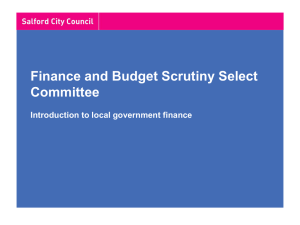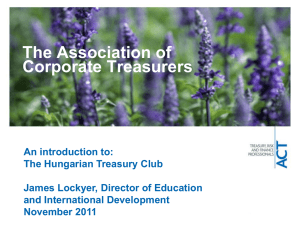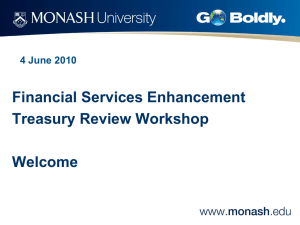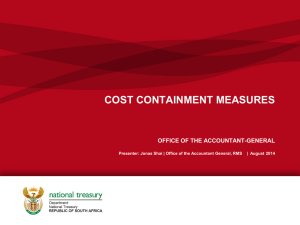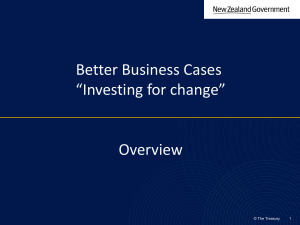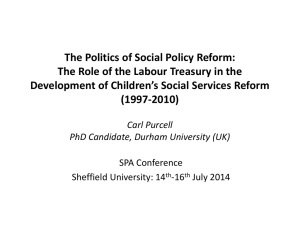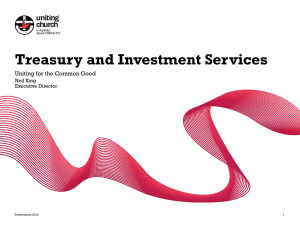Why better business cases? - National Infrastructure Unit
advertisement
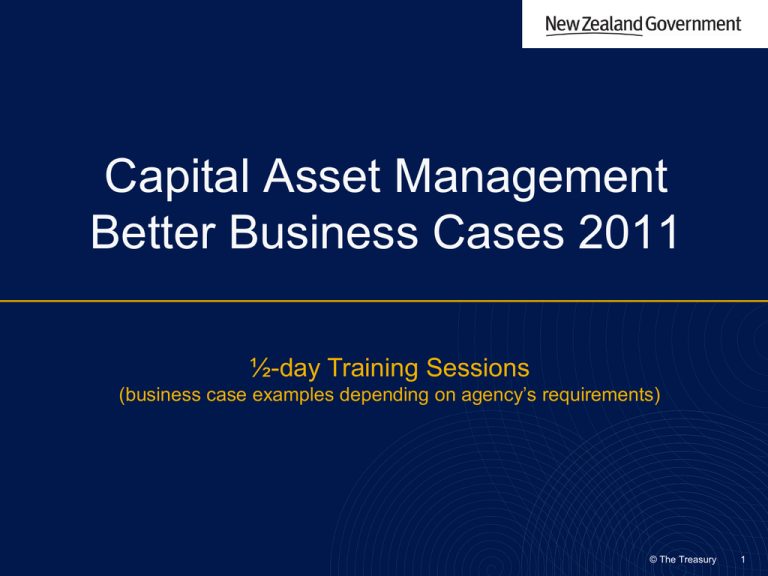
Capital Asset Management Better Business Cases 2011 ½-day Training Sessions (business case examples depending on agency’s requirements) © The Treasury 1 Today’s agenda • • • • Welcome and ground rules Background to CAM & BBC Overview of the Better Business Cases process Lessons from the UK Break - senior managers leave • • • • The 5 Case Model The process in a bit more detail Experts by business case deliverable Practitioners with real-life business case examples (depending on agency’s requirements) • Where to from here and how to get support • Pitfalls: Economic Appraisal – Common Errors (additional lessons from the UK) • Wrap up 2 © The Treasury Background to CAM & BBC • BBC methodology was introduced 1 August 2010 (based on Cabinet Office Circular CO (10) 2)) as part of the Capital Asset Management (CAM) Framework • Initial CAM focus in 2008 was on long term capital planning and asset performance reporting, resulting in agencies providing annual Capital Intentions Reports • In 2010 the cross-agency team adapted UK and Victorian guidance, 5 Case Model and Investment Logic Mapping (ILM) respectively, and Better Business Cases went live in August 2010 • We completed a review with stakeholder groups in February 2011, updated the BBC guidance and released version 2 in July 2011. 3 © The Treasury Overview: Why better business cases? The government wants to improve the quality of business cases to inform their decisions on capital proposals. The BBC process assists this through: Clear rules and expectations • Clear processes • Scalable standards • Clear guidance, training and ongoing support Key stakeholders include: • Decision makers/Ministers • Agency management • Agency business case developers • Monitoring agencies, and • Private sector vendors 4 © The Treasury Overview: When does it apply All capital proposals from Departments, Crown Agents and other Crown Entities, which meet one or more of the following criteria: • Access to new Crown funding • Public Private Partnerships (excluding other Crown Entities) • $25 million whole-of-life cost (Departments only) • “High risk” per Gateway Risk Profile Assessment (Departments and Crown Agents only) • Asset disposals with significant policy decisions 5 © The Treasury Overview: What is expected If a proposal requires Cabinet approval: • Engage them early in the decision-making process • Follow the two-stage process - Stage 1: Based on the Indicative Business Case - Stage 2: Based on Detailed Business Case • Expectation that the process will be used even where approval is not required 6 © The Treasury Overview: Scalability The development process is scalable to ensure that the level of effort is fit for purpose and matches the scale, risk profile and type of decision required. 7 © The Treasury Overview: How The business case development process is designed to produce deliverables to inform the decision making for capital proposals and provide an organising structure for each deliverable. The process is grounded in and linked to: • The 5 Case Model (UK) • Investment Logic Mapping (Victoria, Australia) • The Generic Policy Development Process (Ministry of Economic Development (MED)) • Good practice project & programme methodologies • MED procurement guidance • Public Private Partnerships (PPP) guidance, and • The Budget Process 8 © The Treasury Overview: Who needs to be involved The Better Business Cases process is most successful when: • Agencies engage with central and monitoring agencies in the early stages of each business case deliverable to ensure the business case will be fit for purpose. Agreement will be sought on: – – – – – – Type of business case Timing and nature of decision required Scale and risk of the proposal Scope of analysis required for each case Level of effort and cost for development and assurance Scope of the engagement during the development of the business case 9 © The Treasury Lessons from the UK Better Business Cases for Capital Proposals © The Treasury 10 Lessons from the UK by Joe Flanagan, author of the 5 Case Model • Relevant background – BBC Programme The introduction of a structured methodology to develop and present business cases (5 Case Model) has resulted in: • Improved VfM (Value for Money) • Reduced cost (40%) • Improved efficiency and throughput • Improved outcomes • Better evidenced VfM • Realistic and achievable “do minimums” 11 © The Treasury Lessons from the UK continued • Key cultural changes • Common standard and language • Planning v approval • Business v project assurance • Business needs v benefits • Services v assets • Economics v financials • Earlier consideration of Commercials • The alternative! 12 © The Treasury Break Better Business Cases for Capital Proposals 13 © The Treasury The 5 Case Model Addresses 5 key questions 1. Is there a compelling case for change? 2. Does the selected option optimise public value? 3. Is the potential Deal achievable and attractive to the market place? 4. Is the spending proposal affordable? 5. How will the proposal be delivered successfully? 14 © The Treasury The 5 Case Model The 5 key elements of best practice business cases Applicable strategic fit & business needs Achievable – can be successfully delivered Strategic Management Economic Affordable – within budget Financial Commercial Appropriate – optimises public value Attractive – to supply side and feasible 15 © The Treasury The process (How) in a bit more detail 16 © The Treasury Expert: Strategic Assessment Better Business Cases for Capital Proposals Toolkit: Strategic Assessment © The Treasury 17 Strategic Assessment • What is it for? • When is it needed? • What are the actions? Refer to the BBC Toolkit: Strategic Assessment booklet available on: http://www.infrastructure.govt.nz/publications/betterbusinesscases/strat egicassessment Strategic assessment Action 1 Indicative business case Actions 2-8 Detailed business case Actions 9-24 Implementation plan Actions 25-35 18 © The Treasury Expert: Programme Business Case Better Business Cases for Capital Proposals Toolkit: Programme Business Case © The Treasury 19 Programme Business Case • What is it for? • When is it needed? • What are the actions? Refer to the BBC Toolkit: Programme Business Case booklet available on: http://www.infrastructure.govt.nz/publications/betterbusinesscases/progra mmebusinesscase Strategic assessment Action 1 Indicative business case Actions 2-8 Detailed business case Actions 9-24 Implementation plan Actions 25-35 20 © The Treasury Expert: Indicative Business Case Better Business Cases for Capital Proposals Toolkit: Indicative Business Case © The Treasury 21 Indicative Business Case • What is it for? • When is it needed? • What are the actions? Refer to the BBC Toolkit: Indicative Business Case booklet available on: http://www.infrastructure.govt.nz/publications/betterbusinesscases/indic ativebusinesscase Strategic assessment Action 1 Indicative business case Actions 2-8 Detailed business case Actions 9-24 Implementation plan Actions 25-35 22 © The Treasury Detailed Business Case Better Business Cases for Capital Proposals Toolkit: Detailed Business Case © The Treasury 23 Detailed Business Case • What is it for? • When is it needed? • What are the actions? Refer to the BBC Toolkit: Detailed Business Case booklet available on: http://www.infrastructure.govt.nz/publications/betterbusinesscases/detail edbusinesscase Implementation Strategic Indicative Detailed assessment Action 1 business case Actions 2-8 business case Actions 9-24 plan Actions 25-35 24 © The Treasury Prepare an Implementation Plan Better Business Cases for Capital Proposals Toolkit: Implementation Plan © The Treasury 25 Implementation plan • What is it for? • When is it needed? • What are the actions? Refer to the BBC Toolkit: Implementation Plan booklet available on: http://www.infrastructure.govt.nz/publications/betterbusinesscases/impl ementationplan Strategic assessment Action 1 Indicative business case Actions 2-8 Detailed business case Actions 9-24 Implementation plan Actions 25-35 26 © The Treasury Where to from here & where to get support Better Business Cases © The Treasury 27 Where to go for more support The National Infrastructure Unit (NIU) will: 1. Monitor and periodically update the Better Business Cases guidance on the NIU website and the Public Sector Intranet (PSI) 2. Review, develop and deliver support to agencies 3. Provide facilitation between agencies and their For any queries or for further information please contact: betterbusinesscases@treasury.govt.nz 28 © The Treasury Relevant guidance Relevant guidance can be sourced via the infrastructure web site http://www.infrastructure.govt.nz/publications/betterbusinesscases: • Cabinet Office Circular • Programme Management • Project Management • Public Private Partnership (PPP) Guidelines • Procurement Process • Policy Development Process • Investment Logic Mapping (ILM) • Independent Quality Assurance (IQA) • Gateway Assurance For queries on ILM, IQA and Major Projects Monitoring contact: majorprojects@ssc.govt.nz For queries on Gateway contact: gatewayunit@ssc.govt.nz 29 © The Treasury Economic Appraisal – Common Errors By Joe Flanagan, UK author of the 5 Case Model © The Treasury 30 Common pitfalls to look out for • Not doing an appraisal or creating a proper business case at the outset as an integral part developing the proposal • Not considering sufficient options in long list • Bad short listing, of options • Failure to consider a do nothing option where this is possible • Failure to consider a do minimum option (mandatory) • Failing to include all costs and benefits to society, - just a public sector perspective is wrong, it is incomplete. 31 © The Treasury Common pitfalls to look out for - continued • Double counting costs or benefits (e.g. including costs both in the base case and as a cost saving) • Excluding the cost of using existing assets • Including transfer costs* which should be excluded • Lack of realism or over-optimism about costs, benefits and timings • Failure to carry out sensitivity analysis. • Evaluation proposals absent, no provision for useful feedback (* see notes) 32 © The Treasury Common pitfalls to look out for - continued • Wrong life span of appraisal – whole life is needed • A minimum of 10 years for services (0 to 9) • Failure to include clear reference to sources and assumptions • Wrongly including employment which is displaced and not new • Failure to consider distributional implications • Spurious justification of a non-standard discount rate 33 © The Treasury Wrap up Any final questions or comments? For any queries or for further information please contact: betterbusinesscases@treasury.govt.nz 34 © The Treasury
